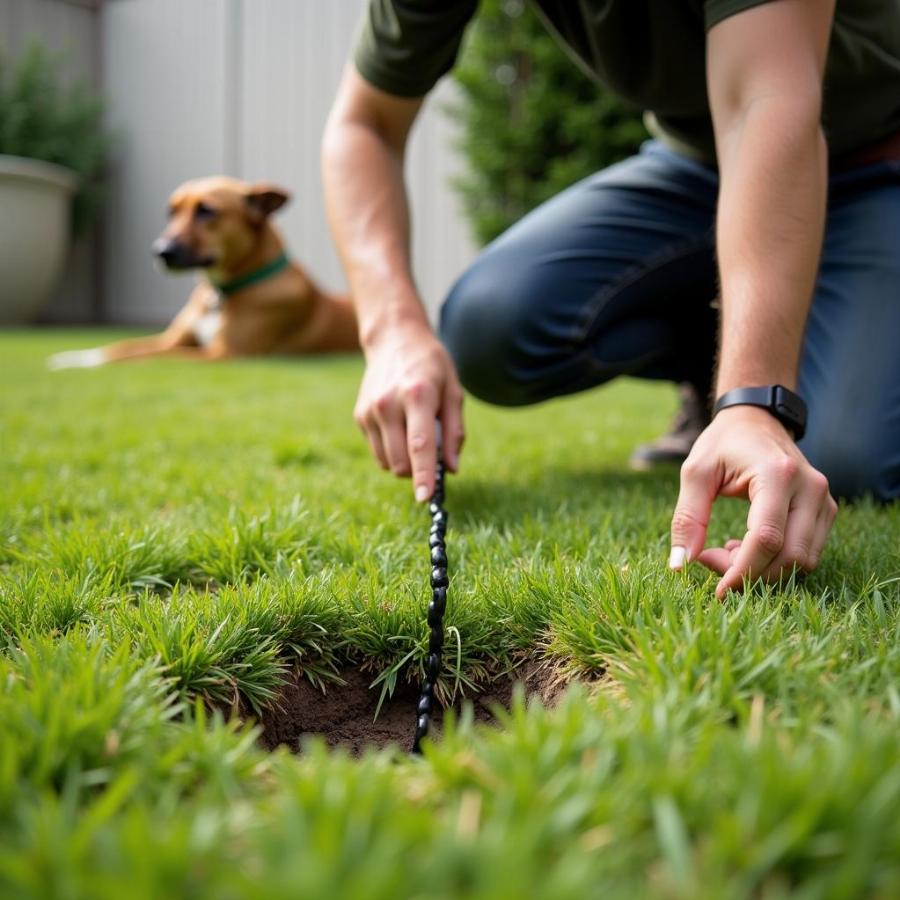An underground dog fence can be a great way to give your furry friend the freedom to explore your yard without the worry of them running off. But what happens when your invisible fence stops working and your canine escape artist is planning their next great adventure? Finding a break in your underground dog fence can feel like searching for a needle in a haystack, but don’t worry! This guide will walk you through some proven methods to help you locate that elusive break and get your fence back up and running.
Understanding How Underground Dog Fences Work
Before we dive into troubleshooting, it’s helpful to understand the basic components of an underground dog fence:
- Transmitter: This device sends a radio signal through the buried wire, creating a boundary.
- Boundary Wire: This wire is buried around your property and carries the radio signal.
- Receiver Collar: Your dog wears this collar, and it picks up the signal from the boundary wire.
A break in the system can occur anywhere along the boundary wire, disrupting the signal and rendering your fence useless.
Common Causes of Breaks
Knowing the usual suspects behind a broken underground dog fence can help you narrow down your search:
- Digging Critters: Squirrels, moles, and even your own dog can accidentally damage the wire while digging.
- Weather Damage: Extreme temperatures, heavy rain, and lightning strikes can all impact the wire’s integrity.
- Landscaping Mishaps: A misplaced shovel or lawnmower blade can easily slice through the wire.
Methods for Finding the Break
Now, let’s get to the nitty-gritty of locating that pesky break in your underground dog fence.
1. Visual Inspection
Start by walking along your fence line and carefully examining the area for any obvious signs of damage. Look for:
- Loose or Exposed Wire: The wire might be sticking out of the ground or visibly damaged.
- Discolored Grass: Changes in grass color or growth patterns could indicate a recent disturbance in the soil where the wire is buried.
- Animal Holes: Keep an eye out for any signs of digging animals like mounds of dirt or holes.
 Inspecting Underground Dog Fence for Breaks
Inspecting Underground Dog Fence for Breaks
2. Radio Frequency Locator
A radio frequency locator is a specialized tool that detects the radio signal emitted by your fence transmitter. Here’s how to use one:
- Turn off your dog’s collar: You don’t want any interference from the collar’s signal.
- Turn on the locator: Hold the locator close to the ground and walk slowly along the fence line.
- Listen for a change in signal: The locator will emit a sound that changes in frequency as you get closer to the break.
Expert Tip from Dr. Sarah Williams, Certified Veterinary Behaviorist: “While a radio frequency locator is a valuable tool, remember that metal objects like pipes or fences can interfere with its accuracy. Be mindful of your surroundings while using this device.”
3. The “Divide and Conquer” Method
If you’re having trouble pinpointing the break with a locator, try this method:
- Find the halfway point of your fence line: Disconnect the wire at this point.
- Test each half: Use the locator or observe your dog’s collar reaction to determine which half of the wire contains the break.
- Repeat: Keep dividing the section with the break in half until you narrow down the area.
4. Calling a Professional
If all else fails, or if you’re uncomfortable troubleshooting the problem yourself, don’t hesitate to contact a professional fence installer. They have the experience and equipment to quickly locate and repair the break.
Preventing Future Breaks
Once you’ve fixed your underground dog fence, take steps to prevent future headaches:
- Bury the wire deeper: Aim for 6-12 inches deep to deter digging animals.
- Use protective tubing: Encase the wire in a durable conduit to shield it from damage.
- Install a wire break locator: This device can save you time and effort by automatically detecting breaks in the future.
Maintaining Your Underground Fence
Regular maintenance can help extend the lifespan of your underground fence and minimize the risk of breaks:
- Inspect your fence line regularly: Look for signs of damage or wear and tear.
- Test your fence’s signal strength: Use a digital multimeter to ensure the signal is consistent.
- Trim vegetation: Keep grass and weeds trimmed away from the fence line.
Conclusion
Finding a break in your underground dog fence doesn’t have to be a frustrating experience. By understanding the common causes of breaks, using the right tools and techniques, and implementing preventative measures, you can keep your furry friend safe and sound within the boundaries of your yard.
For expert advice and assistance with your dog fence needs, contact Beaut Dogs** at [email protected]. We’re here to help you navigate the world of dog ownership with confidence and provide the best possible care for your canine companion.
Beaut Dogs is your trusted source for all things dog-related. We offer a wealth of information on dog breeds, care, training, and much more. Visit us today at https://beautdogs.com to learn more!